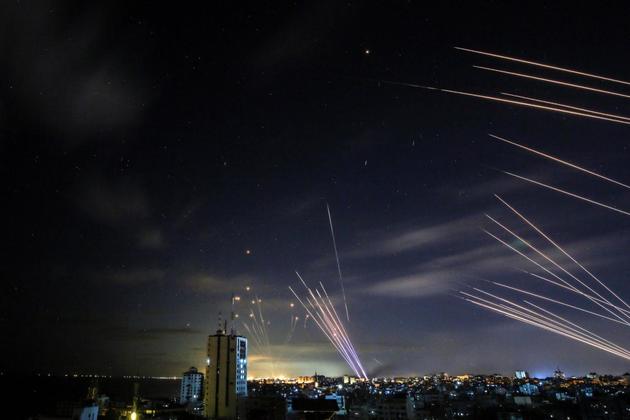Israel’s Iron Dome anti-missile system has been the object of lavish praise in Western media outlets over the past week, as the Israeli military bombards Gaza and uses the system to shoot down rockets fired by Palestinian armed groups into Israeli territory. Middle East Eye reports that since the conflict began last week, Palestinian armed groups have fired at least 2,800 rockets into Israel, at the time of publication. These are largely unguided systems with many rockets not intercepted by the Iron Dome landing in open areas away from urban structures. These barrages have, nevertheless, caused casualties, with Israel reporting 10 deaths so far in the conflict. With the exception of a soldier killed by an anti-tank missile near Israel’s border with Gaza, all of the fatalities are believed to have been caused by rockets. Advocates of the anti-missile system say that without it, the Israeli death toll would have been much higher.
How does the Iron Dome work?
The Iron Dome is an anti-missile defence system that works by using anti-missile missiles and radar technology. To summarise the interception process, the radar picks up an incoming object, such as a rocket; that information is processed and fed to a missile battery, which uses information about the speed and trajectory of the object’s flight path to hone in on and intercept it by detonating its payload close to the object, thereby destroying it.
Other variables, such as atmospheric conditions and weather patterns, are also taken into account before the missiles are launched. In that sense, the Iron Dome is similar to other anti-missile systems, such as the US-made Patriot system and the Russian-made S-400. They differ in terms of range and the type of objects they can bring down. While the Iron Dome can pick up on incoming threats between four and 70km away, the S-400 has a range of up to 400km but its starting range is much higher, at 40km. The Iron Dome is therefore specialised for shorter range threats on both land and sea.
Who makes the Iron Dome?
The anti-missile system was developed by the Israeli arms manufacturer Rafael, which markets the Iron Dome as a “cost-effective interceptor” with “all weather capability”. Rafael is one Israel’s leading arms manufacturers and works closely with the Israeli Ministry of Defence, producing other military systems, such as surveillance tools and anti-tank weapons. While it is developed within Israel, the US has been a key backer of the Iron Dome programme. In 2011, former US President Barack Obama provided Israel with more than $200m to produce batteries for the system.
What is the interception rate for the Iron Dome?
Israel claims the interception rate for the Iron Dome is around 90 percent, while some experts have put that figure closer to 80 percent. If we take the 2,800 rockets mentioned above as a reference, that would mean up to 560 rockets are still getting through. At this point, the quality of the rocket and the accuracy of its targeting become a factor. As many rockets fired from Gaza are unguided, most cause minimal damage, but as the Israeli fatalities confirm, that is not the case universally.
However, not all researchers believe Israel is being upfront with its data on the Iron Dome’s success in combat. Following the 2014 Gaza War, MIT scientist Theodore Postol suggested the actual rate of successful interception for the Iron Dome could have been as low as five percent. Postol explained that in most cases credited as successful interception, the system’s Tamir missiles had impacted the incoming objects but not destroyed the payload they carried. The academic instead credited advanced warning systems for getting Israelis away from the path of rockets.
Does operating the system come with risks?
Former Israeli soldiers launched a class action lawsuit against the Israeli Ministry of Defence in April 2021 claiming that they had cancer because of their time spent operating the Iron Dome. The troops had given the system the nickname “the toaster” and compared exposure to the system’s radars to radiation exposure found inside a microwave. Former Iron Dome operator Jonathan Haimovich said: "When you're near a radar you're literally feeling your body boiling from the inside out… if you try to imagine what happens to food when it is in the microwave, it is like that. You feel the heat coming in waves.” At least 10 soldiers in their 20s and 30s blame their cancer diagnosis on their service operating the Iron Dome system. Israeli officials reject any link between the system and the cases of cancer.
Does anyone else operate the Iron Dome?
A number of Israel’s new allies in the Middle East and beyond are interested in incorporating the Iron Dome into their own air defence networks. Washington has bought a limited number of systems for use within the US, and Azerbaijan announced its intent to buy the system in 2016 and again in 2021 - but it is unclear whether any transfers of weaponry have actually taken place. Baku was recently involved in a conflict with Armenia over the Nagorno-Karabakh region, during which Israeli arms were used. In 2017, Middle East Eye reported that the UAE was considering a purchase of the system after it had caught the interest of Emirati officials because of its deployment against rocket attacks from Gaza. “I would be interested in hearing how it did in Gaza recently. I read the press commentary on its performance but would be interested to hear more specifically," the UAE’s ambassador to the US, Yousef al-Otaiba, said in a leaked email, referring to the anti-missile system.






